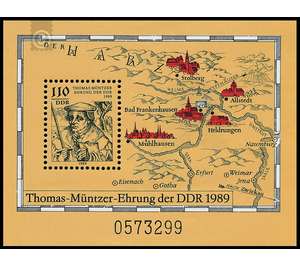Commemorative stamp series - Germany / German Democratic Republic 1989
Theme: Calender
| Country | Germany / German Democratic Republic |
| Issue Date | 1989 |
| Item Type | Block |
| Chronological Issue Number | 3200 |
| Chronological Chapter | GER-DDR |
| SID | 765281 |
| In 17 Wishlists | |
Thomas Müntzer Honoring the GDR On the occasion of the GDR's commemoration of the GDR, the Ministry of Posts and Telecommunications of the German Democratic Republic is the first to issue a multi-colored special postage stamp block. Special cancellation from 21st March to 20th May 1989 But the people do not doubt 1989 The German Democratic Republic honors Thomas Müntzer on the occasion of his 500th birthday. In the Thomas Müntzer Committee, which under the chairmanship of the Secretary General of the Central Committee of the SED and Chairman of the State Council of the GDR, Comrade Erich Honecker, constituted, representatives of all social forces of the GDR with. With Thomas Müntzer, the GDR honors the man who, on the side of the rebellious people, led the Reformation to victory, wished to fight for power for the people, and thereby tragically failed. With this honor, the understanding of heritage and tradition, as it was already stated in 1983 with the Martin Luther honor, affirmed. The dialectical connection between the Reformation and the Peasants' War, by Luther and Müntzer as representatives of different class lines of one and the same revolution, is underlined. Although we believe that we know Müntzer's face, every contemporary representation of him is missing. The representation of the face on the mark of the small block adapted representations from the 17th century or 18th century: - Tomas Muncer, preacher to Alstet in Duringen. Engraving 1608 Amsterdam by the Dutch engraver Christoph van Sichern and - Thomas Müntzer, full-length figure with sword and bible. Copper engraving from 1701 by the Dutch engraver and brilliant representative of the Dutch late Baroque Romeyn de Hooghe with the head of the famous Baptist leader Jan Matthijs from the portrait of Christoph van Sichern, copperplate engraving 1608. In the background the lightning from a cloud symbolizes the effect of Thomas Müntzer's words in the time of the German early bourgeois revolution. The bird on the tree is a reference to the reformer dr. Martin Luther after a title page of a pamphlet from 1523 by Hans Sachs: "The Wittenbergisch nightingale, the man yetz hears everywhere". A stylized map of the Thuringian-Saxon sphere of influence Thomas Müntzer contains as a guide next to the course of the rivers Saale, Unstrut, Gera and helmets and the mountains of the Harz and the Kyffhäuser mountains with the Kyffhäuser monument the location of the cities Eisenach, Gotha, Erfurt, Weimar , Jena and Naumburg and indicated by a directional arrow the location of the city Zwickau. The commons and memorials of Thomas Müntzer in this room are highlighted by small vignettes: - Stolberg in the southern Harz (district Halle), where Thomas Müntzer was probably born in 1489. (Renaissance castle and parish church of St. Martin) - Allstedt (district of Halle), 1523/24 pastor of St. John's Church, founder of the "Allstedter Federation", 13 July 1523 in the castle in the chapel he held the "prince sermon". (Castle with gate tower) Mühlhausen (district of Erfurt), 1524 Foundation of the "Eternal Covenant of God" under the rainbow flag, 1525 Müntzer pastor in St. Mary. (Medieval town view with city wall, towers and gates) 27th May 1525 Execution of Müntzer in Görmar near Mühlhausen. - Bad Frankenhausen (district of Halle), on the 15th time in 1525, the Thuringian uprising near Frankenhausen is bloodily defeated and Müntzer captured. (Lower Church, above the Peasants' War panorama with the monumental picture of Werner Tübke "Early Civil Revolution in Germany") - Heldrungen (District Hall), 15 - 24 May 1525 captivity, torture and interrogation Müntzers in the moated castle. (Castle with moat) A cartographic scale, but only used as a creative tool, forms the frame.


